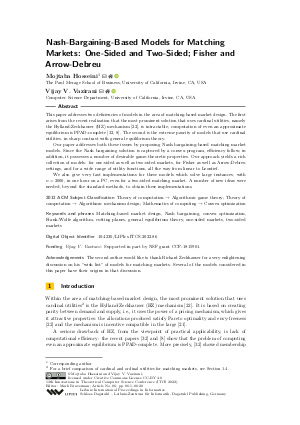LIPIcs.ITCS.2022.86.pdf
- Filesize: 0.88 MB
- 20 pages

 Creative Commons Attribution 4.0 International license
Creative Commons Attribution 4.0 International license

This paper addresses two deficiencies of models in the area of matching-based market design. The first arises from the recent realization that the most prominent solution that uses cardinal utilities, namely the Hylland-Zeckhauser (HZ) mechanism [Hylland and Zeckhauser, 1979], is intractable; computation of even an approximate equilibrium is PPAD-complete [Vazirani and Yannakakis, 2021; Chen et al., 2021]. The second is the extreme paucity of models that use cardinal utilities, in sharp contrast with general equilibrium theory. Our paper addresses both these issues by proposing Nash-bargaining-based matching market models. Since the Nash bargaining solution is captured by a convex program, efficiency follow; in addition, it possesses a number of desirable game-theoretic properties. Our approach yields a rich collection of models: for one-sided as well as two-sided markets, for Fisher as well as Arrow-Debreu settings, and for a wide range of utility functions, all the way from linear to Leontief. We also give very fast implementations for these models which solve large instances, with n = 2000, in one hour on a PC, even for a two-sided matching market. A number of new ideas were needed, beyond the standard methods, to obtain these implementations.

































Feedback for Dagstuhl Publishing